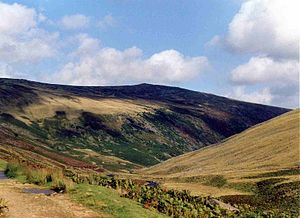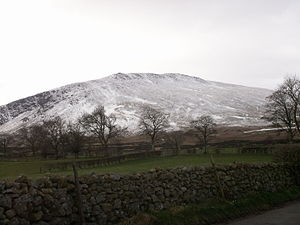Carrock Fell
| Carrock Fell | |||
| Cumberland | |||
|---|---|---|---|
 Carrock Fell from the Caldew Valley | |||
| Range: | Caldbeck Fells | ||
| Summit: | 2,175 feet NY341336 54°41’37"N, 3°1’23"W | ||
Carrock Fell is a fell in Cumberland, amongst the Caldbeck Fells in the northernmost part of the Lake District, eight miles north east of Keswick. The fell's name means "Rock Fell", from the Cumbric carrec, meaning a rock.
The Ordnance Survey have demoted the fell's height by six feet in recent years, giving it a height of 2,168 feet in the most recent map updates after having recorded it at 2,175 feet many years, which is reflected still in guidebooks.
Landscape
Alfred Wainwright rated Carrock Fell as the second most exciting and interesting fell in the northern area of Lakeland (after Blencathra and before Skiddaw), it has special appeal regarding geology, mining and history and its rocky nature makes it stand out from the neighbouring fells which are mainly grassy and smooth.
Carrock Fell is bounded to the south and east by the River Caldew into which all drainage from the fell goes to find its way eventually to the Solway Firth.
Geology
Carrock Fell’s geology is unique in the Lake District in that it is predominantly composed of Gabbro, a rough igneous rock that also makes up the famous Black Cuillin on the Isle of Skye. Gabbro is an excellent “clean” rock for climbers and Carrock Fell offers the only rock climbing of quality in the northern fells, the majority of which are made up of the unsuitable crumbly Skiddaw Slate.
The fell is rich in mineral ores and has been mined extensively for many centuries with tungsten, lead, arsenic and iron all being extracted from the fell. The most famous mine on the fell was the Carrock Mine, the only source of tungsten in Britain outside Devon and Cornwall. The mine was situated in Grainsgill Beck on the south western flanks of the fell with the main adit at a height of 1,115 feet. The mine was opened in 1854 but has only been worked in periods when the price of tungsten has been high, for example during war time, the mine was worked extensively during both World Wars and the Korean War when supplies of Tungsten were threatened. The mine closed in the early 1980s and in 1988 the site was bulldozed and landscaped to its original outline.
History
Carrock Fell is also the site of an Iron Age hill fort which crowns the summit. Only the foundations of the walls remain. The fort is oval shaped and is believed to have been built by Iron Age Britons and destroyed by the Romans in their conquest of these northern lands.
In modern days, Carrock Fell's main claim to historical fame is that it was climbed by two of the Victorian Age's best-read novelists, Charles Dickens and Wilkie Collins, who climbed the fell in 1857 during a tour of northern Cumberland. Dickens had read about Carrock Fell and had made up his mind to climb it. Collins sprained his ankle and Dickens had to help him back down the mountain, according to The New Yorker 7/25/11 in an article by Jonathan Rosen. Later, Collins and Dickens collaborated on a humorous narrative based in part upon their climb up Carrock Fell, entitled The Lazy Tour of Two Idle Apprentices.[1]
Ascents
Despite all its other attractions, Carrock Fell is primarily the haunt of the fell walker; it is mostly climbed from the surfaced road which goes to the site of the Carrock Mine. It is possible to leave a car at NY328326 and then climb the fell by the steep south-west slopes. Carrock Fell can also be climbed from the road between Mungrisedale and Hesket Newmarket, threading a way through the craggy and bouldery eastern slopes known as "Apronful of Stones".
Summit
The top of the fell offers a good view to the east towards the Pennines across the Eden valley.
Carrock Fell has two subsidiary summits: Round Knott (1,978 feet) and Milton Hill (1,991 feet) which lie to the west of the main summit on the ridge which continues to the adjoining fell of High Pike.

Outside links
References
- Wainwright, Alfred: A Pictorial Guide to the Lakeland Fells, Book Five — The Northern Fells (1962)
- Bill Birkett: Complete Lakeland Fells, ISBN 0-00-713629-3
- The Mountains of England and Wales, John and Anne Nuttall ISBN 1-85284-037-4
- Dickens' visit to Carrock Fell